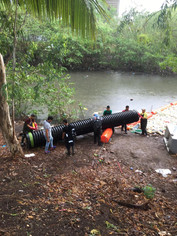B.O.B. Litter Trap


Our first project in this topic consists of the installation of our barrier “B.O.B (Barrier or Garbage)” in the Matías Hernández River. B.O.B was a floating barrier that trapped the debris brought by the riverbed, preventing it from reaching the coast and therefore the mangrove, as well as facilitating its collection.
This is a system that has been tested in other countries and in the same way was effective in Panama, so it is expected that it can be replicated in other rivers that present the same problem.
B.O.B received its first heavy rain on April 6, 2019, which brought tons of trash that was collected in 470 jumbo bags. Until December of the same year, more than 10,000 garbage bags were collected, which is equivalent to more than 70 tons. Likewise, more than 50 refrigerators, piles of tires, cars, suitcases, and 2 tubes of 3m long used regularly for aqueduct and sewer systems were also collected.
After receiving several heavy rains and seeing the amount of garbage that went down the river, we made some adjustments to the B.O.B to improve its effectiveness in stopping the floating waste that the water brings.
In 2020, B.O.B received the first rain of the year on April 12, bringing with it an exorbitant amount of waste. During the dry season of summer, the barrier did not receive much garbage due to lack of rain that drags the waste accumulated in the streets, gutters and streams, towards the river.
The B.O.B operated until July 20 of the same year, the day it was uninstalled. During the year and a half of operation, B.O.B managed to retain more than 100 tons of waste that would otherwise have ended up on the coast and in the sea.






¿Did you know that 46.7% of the garbage captured by the B.o.B in the Matías Hernández River is plastic bottles and disposable foam containers?
In October 2019, Marea Verde concluded the study “Characterization of the discharge of macro-plastics and other post-consumer floating solid waste in the Bay of Panama by the Matías Hernández River.”
The purpose of this study developed at the B.o.B was to generate data on the types of waste dumped by the population in the Matías Hernández River basin, which are later discharged into the mangrove swamp of the Panama Bay and the ocean, specifically, plastics and other floating solid waste, considered the main components of marine litter generated on dry land, according to the United Nations Environment Program (UNEP, 2009).
During the study, 26 fractions were analyzed in 50 samples taken from the B.o.B, with a total weight of 238.2 kg. In the following graphs it can be seen that the floating solid residues most captured by the barrier were plastic PET bottles (Polyethylene Terephthalate) with 29.5% of the total weight, followed by the disposable containers of expanded polyethylene (EPS), popularly poorly called “foam”, with 17.2%.
The study was carried out for four (4) months, with the support of more than 60 volunteers, and led by Panamanian engineers Carol Simons, Nayrobis Rodríguez and Álvaro Quirós, and will serve as a baseline for future measurements of the impact of educative actions as well as of recycling in the populations of the upper and middle river basin, in addition to being the first national benchmark for similar studies in other rivers.






ReBoB
Our ReBoB is a new prototype of a waste containment barrier built by Ing. Robert Getman based on recycled materials such as plastic bottles and used tires. On December 10, our team, together with the Don Bosco Community Board, installed the new ReBoB made of recycled materials in the Tapia River, in order to trap the waste that goes down this river. For this prototype, 75 tires and approximately 800 plastic bottles donated by area residents and civic clubs, were used during a Drive Thru that we organized together with the Community Board and Costa Recicla.
The ReBoB has been working efficiently and we hope it can be a new incentive to replicate these types of barriers to prevent waste from reaching the sea, while also giving a second use to materials that would normally be considered garbage.
